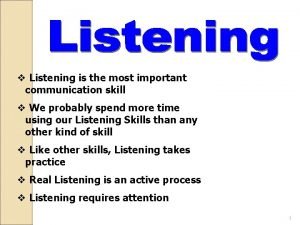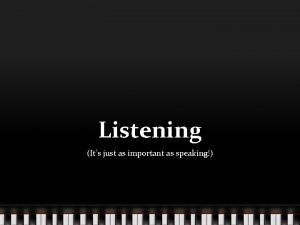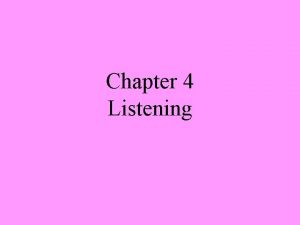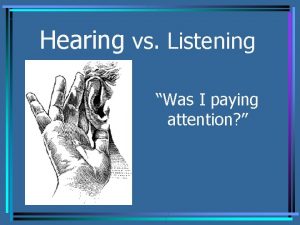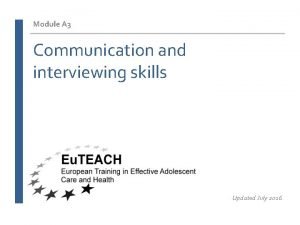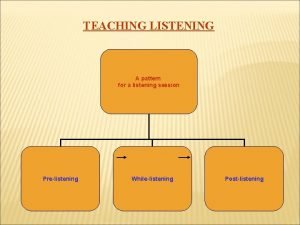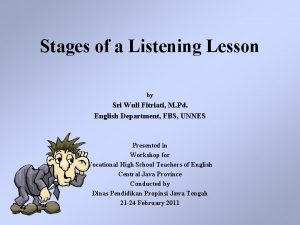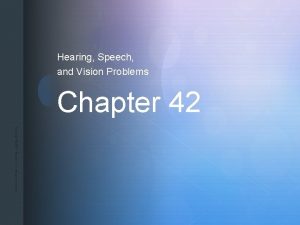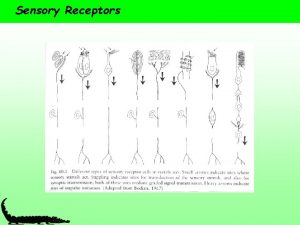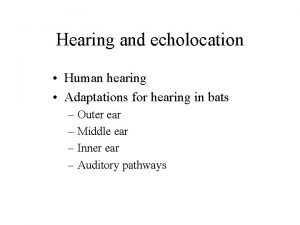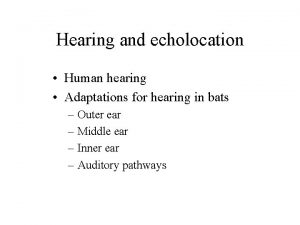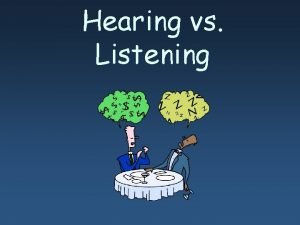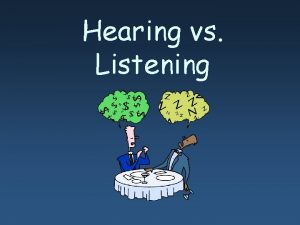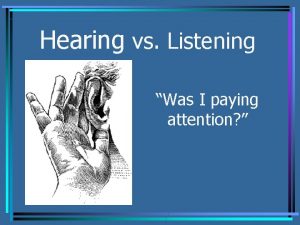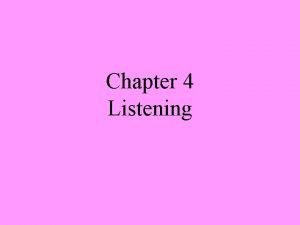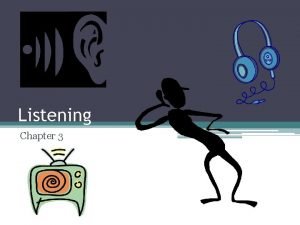CHAPTER 3 Listening Listening Hearing physiological response Listening






















- Slides: 22

CHAPTER 3 Listening

Listening Hearing – physiological response Listening – active, cognitive process Feedback Loop — Successful speakers adjust their messages based on reactions from listeners in a circular response.

Hearing vs. Listening • Hearing – your ears pick up sound waves being transmitted by a speaker • Listening – making sense out of what is being transmitted

Hearing vs. Listening “Hearing is with the ears. . . listening is with the mind. ”

Reasons why we Listen Enjoyment Empathy Understanding & Comprehension Critical Listening/Evaluation There is no such thing as easy listening…. It’s a radio format

Competent Listeners Have more successful relationships Experience greater professional success Are better problem solvers Are more engaged citizens Learn from listening to other speakers

Components of the Listening Process Mindfulness Physical reception of communication Selective perception of communication Organizing perceived communication Interpreting communication Responding to others nonverbally Remembering communication

Selective Perception We pay attention to one message while ignoring another. For example, walking to your next class, you ignore your friend to answer your cell phone. Listeners pay attention to a message based on its importance, its relevance to listener, and the level of understanding.

Dialogic Communication To occur, the speaker and listener must create meaning for the message together. A speech is not a monologue by which the speaker tries to impose her beliefs and thoughts on the audience like she would enter data into a computer. Speeches are dialogues by which the speaker and the listener share ideas collaboratively; both take an active role in the process.

Critical Thinking The ability to evaluate claims on the basis of well-supported reasons. Audience members should evaluate the evidence for accuracy and credibility. Pay attention to assumptions and biases, such as overgeneralizations which are unreasonable and unsupported conclusions.

Guidelines for Evaluating Messages Be honest and fair in your evaluating by being open to other viewpoints and considering the speech as a whole. Adjust to the speaker’s style of delivery, especially with your classmates who are learning how to improve their word choice and gestures. Be compassionate in your criticism by providing constructive feedback.

Factors that have reduced listening skills We move at a fast pace in everyday life. Media outlets encourage passive listening. Commercials and other “mini-messages” contribute to difficulty in sustaining attention for long periods of time. Try this: Count the mini-messages during your favorite TV sitcom using your stopwatch. How much time elapsed between commercial breaks or scene changes? How long was each commercial? Did you have any interruptions during the sitcom; i. e. telephone ringing, person entered room, your pet barked?

Listening Distractions Thoughts and feelings that intrude on our attention are internal listening distractions or obstacles. Daydreaming, anxiety, illness, or fatigue are examples of common distractions. Scriptwriting is when the listener is to busy to listen because he is thinking of what to say next. Defensive listeners prejudge the message and assume they already know the information or that the speaker is against their values. Cultural differences impact how well we listen.

Active Listeners Set listening goals. Listen for main ideas. Watch for the speaker’s nonverbal cues. Did you ever try to tune out the speaker as this child is doing?

Steps in Setting Listening Goals Identify your need for listening to the speech. Indicate the performance standard to demonstrate effective listening has occurred. Make an action statement where you visualize minimizing internal distractions and listening well. Assess goal achievement by taking a moment to review your evaluation sheet to confirm that you did an adequate job as a listener.

Listen for Main Ideas Listen for the organizational pattern of the message. Listen for the internal preview in the introduction, transition statements and signposts between the main ideas, and match these with the concluding review. Take notes on the main ideas and supporting evidence.

Watch for Nonverbal Cues Pay attention to direct eye contact; speakers often emphasize important thoughts by gazing directly at the audience. Emphatic gestures and changes in facial expressions often indicate important concepts or strong feelings on the part of the speaker.

How to Listen Effectively • Avoid fake listening

The Listener’s Responsibilities • Show courtesy and respect

The Listener’s Responsibilities • Reject electronic intrusion

The Listener’s Responsibilities • Know that multitasking mars performance

Tip 3. 3 Confront Electronic Rudeness
 Pseudo listening definition
Pseudo listening definition The importance of listening
The importance of listening Listening vs hearing
Listening vs hearing Types of listening
Types of listening Factual distractions
Factual distractions How would one use ears for utilizing spare listening time
How would one use ears for utilizing spare listening time Listening vs hearing
Listening vs hearing Hearing vs listening
Hearing vs listening Barrier in listening
Barrier in listening Listening vs hearing
Listening vs hearing Proxemics in communication skills
Proxemics in communication skills Pre listening while-listening and post listening examples
Pre listening while-listening and post listening examples Stages of a listening lesson
Stages of a listening lesson Chapter 42 hearing speech and vision problems
Chapter 42 hearing speech and vision problems Natural and forced response
Natural and forced response Natural and forced response
Natural and forced response Primary immune response and secondary immune response
Primary immune response and secondary immune response What are the different types of sensory receptors
What are the different types of sensory receptors What is the rising action of romeo and juliet
What is the rising action of romeo and juliet Hearing on advisement
Hearing on advisement Leitfaden personalauswahl
Leitfaden personalauswahl If only i could fly asl story script
If only i could fly asl story script Icd 10 otomycosis
Icd 10 otomycosis

